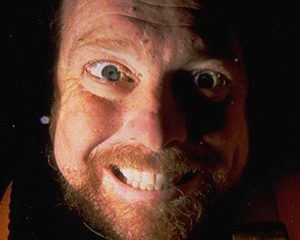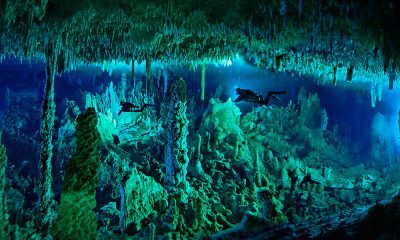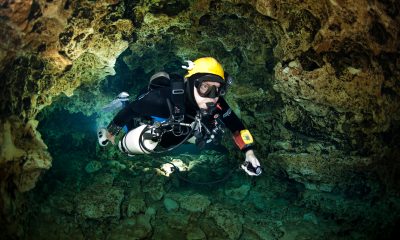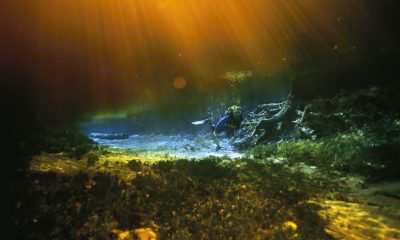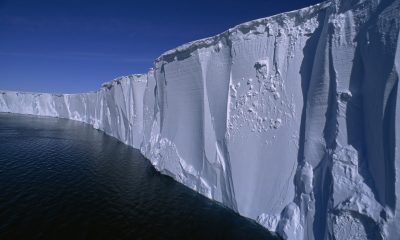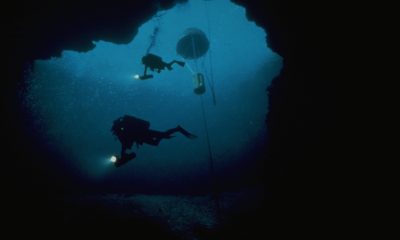Cave
Water Boy
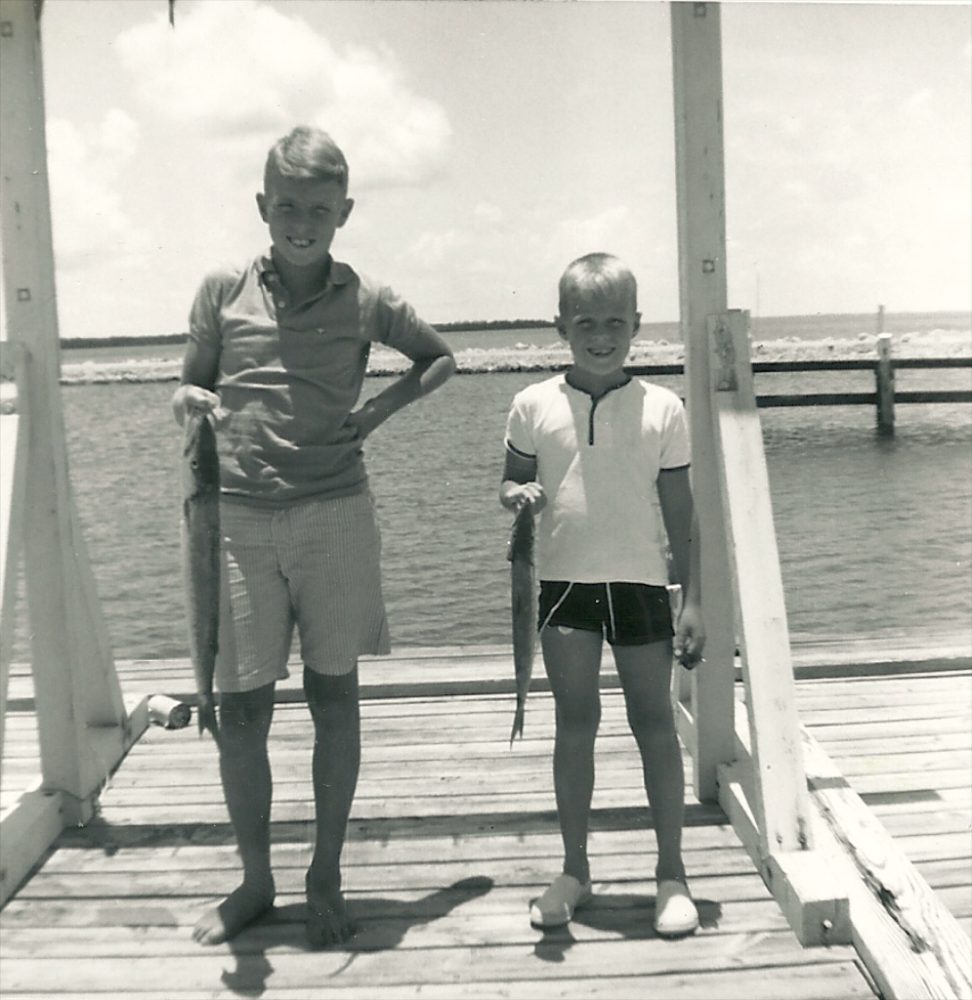
by Julie Hauserman. Header image of Wes (R) with his brother Jimmy (L). Photo courtesy of Terri Skiles.
Here is an excerpt from her book, Drawn to the Deep: The Remarkable Underwater Explorations of Wes Skiles, Chapter 2: Water Boy
Wes’s first visit to North Florida’s Ginnie Spring is on a winter’s day in 1971. He is 13, and here for a special mission.
It’s a wild place then, and first he has to bushwhack through the thick, green tangle that is Florida, spider webs hitting his eyes, bugs buzzing his ears, and prickers snagging his shins. Then he’s at the edge of a 50-foot-wide swimming hole that looks like some Hollywood movie set of the mythical paradise, Shangri-la.
The sun glints off a baby-powder-white sand bottom. Florida’s domed sky tints the pool impossibly blue. It’s so clear you can see everything – swimming fish, turtles, waving water plants, fallen tree branches; it’s as if there’s no water there. Below the water’s surface, outcroppings of pale craggy limestone shimmer; the prehistoric reef that is Florida’s bones.
Then the spring goes deeper and darker toward a shadowy cave entrance at its bottom. Swim into it, and the force of the water coming out of that cave will blow you back.
Cartoony cypress knees poke up around the spring’s forested edges, and, higher up, gray-green Spanish moss makes lacy veils in the upper branches. The spring empties to the Santa Fe River in a lovely sand-bottomed stream that’s lined with arching trees. Where the river meets the spring, there’s a visible line between the clear spring flow and the dark, tannin-stained river water.
When Wes looks into that reflecting spring, he knows with sudden certainty that he wants to do more than swim on its surface. He wants to go inside it.
His two companions have sternly warned against it. Wes is with his older brother, Jim, and the Skiles’ family neighbor, Kent Markham. They’ve traveled here from Jacksonville, where they live in low-slung a middle-class neighborhood that’s typical of Florida in the 1950s. Revolutions may have been unfolding around them –civil rights demonstrations, people protesting the Vietnam War, and the flowering 1960s counterculture, — but in the Skiles family, it was still a buttoned-up, God-and-country, Baptist church world. Wes and his brother Jim wore buzz cuts; big sister Shirley wore crinolines, saddle shoes, and Bobby socks. Their family life revolved around water. In those days, Jim Skiles remembers, “Mom not only drove us to the beach all the time, but I have vivid memories of walking out of junior-high school at the end of the day, where the bus pickup was, and seeing Mom in her blue Valiant, with three surf boards loaded on top of the car, waving, like, “Come on, the surf is good, let’s go surfing.”

“She didn’t surf, but she was that good of a mom that she would load up our boards, and the boards were, of course, 9-foot-6 inches. I mean, they were big longboards back then, you know? I was small enough I couldn’t even get the board on top of the car by myself. So yeah, that was the kind of mom she was. I mean, she constantly put us ahead of her. Wes was young, but I took Wes surfing with me, and Wes fell in love with surfing, too.”
Wes’ sister Shirley says: “The hardest thing was getting those boys out of the water. Mom and Dad would be giving them the evil eye, you know, ‘Now! Get out Now!”
When he reached driving age, Jim would load up surfboards and buddies in his slick black 1953 Ford Fairlane.
“One of the surfing trips, Wes comes running out, ‘I want to go! I want to go!’” Jim says. “And I’m thinking: Ugh. And I said ‘All right, Wes, the only spot we have is if you can squat down on the floorboard of the car’ and he goes ‘OK!’ I mean it was only a 12-minute ride to the beach or something. He actually got down and crouched on the floorboard under all of the guys’ legs. Wes got accustomed at an early age to be in tight spots.”

Wes was wild about the outdoors, but in school he was an unmotivated student and had trouble sitting still. He was athletic, and might have dedicated himself to the surfer’s life, but the coincidence of living near Mr. Markham changed his trajectory.
Markham was a high school science teacher, and, on his off time, an inventor. In the mid-1960s, just down the street from the Skiles house, he was creating an unusual device, a futuristic, portable, one-man “sport submarine.”
Fashioned out of plywood, metal tubing, fiberglass, and plastic, it looked like it belonged on The Jetsons TV cartoon. The craft was space-age cool, and if you look at pictures of it today, you see a quirky artifact native to that particular time and place. Just 165 miles down the Atlantic beach coast, scientists and astronauts at Cape Canaveral were readying the Apollo ship to rocket men up into space and walk on the Moon for the very first time.
Powered by a marine trolling motor, the Markham Sport Submarine had Delta wings, a pointed nose, and a pop-up clear bubble over the diver’s seat. Coolest of all, an onboard air tank and a battery pack made it possible for a diver to explore underwater without putting on a SCUBA mask. Markham called it a “semi-dry submarine,” because anyone who used it had their upper body dry but their legs and torso underwater. The diver sat in the air-filled chamber, breathing comfortably, while watching the underwater scenery pass by through a clear “dashboard.”
Before Markham’s invention made the cover story of Popular Science (“Build This One-Man Sub!”) Markham had to field-test it. He turned to his enthusiastic young surfer neighbor, Jim Skiles, for that task.
“I think he had two daughters who weren’t very interested,” Jim explains. “Wes and I were both water bugs. We were fascinated with Jacques Cousteau and that was the very early days of Jacques Cousteau’s show on TV.”
Jim was in junior-high school and on his way to becoming a YMCA swim teacher and Jacksonville Beach lifeguard when Markham asked him and another teen from the neighborhood to help test-drive the Sport Submarine.
Wes was too small to go on that trip and was crestfallen that he’d been left out of the adventure. The test run went perfectly. Markham’s invention made the Popular Mechanics June 1968 cover. (Later, Markham made his plans widely available: If you sent $6 to the science teacher, he’d mail you the details on how to build the Sport Submarine.)
Once Markham finished his sub, he started working on something more portable to help SCUBA divers explore farther and faster through the depths.
By 1971, Wes had taken snorkeling classes at the YMCA pool and was so focused he got his SCUBA diving certification at age 13. When Markham once again needed test drivers that year for his underwater scooters, he asked Wes and Jim to come along.
“Because Wes was so disappointed that he didn’t get to go out on the initial trip on the submarine, Mr. Markham said, ‘OK, I’m working on something else.’ And it was these little, handheld, early underwater scooters,” Jim recalls.
In Jacksonville, Markham loaded up Wes, Jim, and the scooters and drove 75 miles inland to Ginnie Spring.
“It was winter time, and Mr. Markham had got us full wetsuits,” Jim recalls. Ginnie Spring is a constant 72 degrees year round. In the hot summer, the spring water seems freezing, and people squeal with shock when they jump in. In winter, cold air makes the spring water seem warm.
“You would get down there with that scooter and start scooting along and having so much fun,” Jim said. “We didn’t have tanks on, and all of a sudden you go, ‘I’m out of breath!’ and have to surface. It was so neat to go out of that spring and swim to the river and do a U-turn back to the spring, because you go from this brown cold river water and start going back through the spring, and it’s like you’re going through a warm bath.”
A Popular Mechanics photographer brought something that day: A Super 8 Movie camera. He had made a special Plexiglas box to fit around the camera so he could shoot film underwater. (Up in New England, on Martha’s Vineyard Island, Steven Spielberg was also using a Plexiglas box around his camera to get the haunting half-above-water-half-below-water swimming shots for the landmark shark horror movie, Jaws.)
Wes was fascinated, and he recalled later:
“The photographer had five or six cameras and he went ‘Here, take one of my Nikons and take some pictures.’ The first thing I did was, I went in the cave. Everyone told me ‘Don’t go in the cave,’ but I went in the cave. I got this shot of (my brother) scootering past the entrance and the shot came out really good. I was hooked from that point on.”
That day at Ginnie Spring, it was the day Wes and the underwater world got hitched for life.
To explore more stories, documentaries, videos and articles by and about Wes Skiles click here: Celebrating Wes Skiles
Dive Deeper:
Julei Hauserman talks about her book, Drawn to the Deep, The Remarkable Underwater Explorations of Wes Skiles, Winner of the 2019 National Outdoor Book Award for History/Biography
Buy the book here: Drawn To The Deep

Julie Hauserman, an award-winning journalist, is editor-in-chief of the Florida Phoenix. She is a former national commentator for NPR’s Weekend Edition and a former capitals bureau reporter for the St. Petersburg’s Times.
Tags: Wes Skiles, Ginnie Springs
















